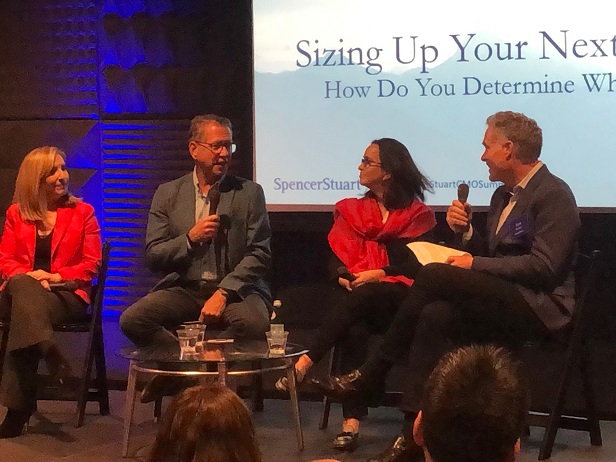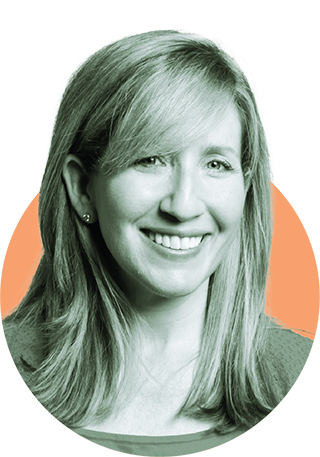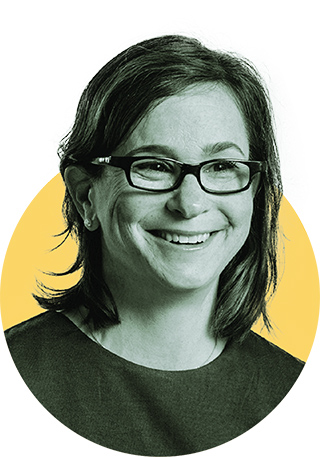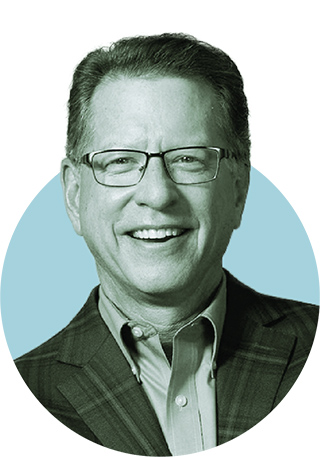As CMOs play an ever-increasing role in corporate leadership, the path to success is evolving rapidly. Top CMOs must be equipped with not only the functional skills and expertise required of a top marketer, but also the courage and determination to challenge the status quo, push for change and drive growth.
So when a new opportunity arises, how do you determine whether you’re right for the job, and whether the job is right for you? How do you know if your current job is the right one for now, or if a new role is worth taking on?
Purpose, path and people emerged as key elements to answering those questions during the panel discussion at Spencer Stuart’s sixth annual West Coast CMO Summit, where the topic was how CMOs can determine when a new job opportunity is the right one. The panel included three accomplished marketing leaders who had navigated many steps in their career journeys:
-
Jennifer Dulski, former head of groups and community at Facebook
-
Mike Linton, chief revenue officer at Ancestry
-
Blair Shane, former partner and chief marketing officer at Sequoia Capital
Here are some of the key takeaways from our summit discussion about the CMO’s career path.

From left: Jennifer Dulski, Mike Linton, Blair Shane and Tom Seclow
Purpose, path and people: The elements of the right job
According to Dulski, purpose, path and people — which she has dubbed the “3 Ps” — emerged from 20 years surveying people she worked with about what motivates them at work. After compensation and location, these 3 Ps stood out clearly in her research:
-
Purpose. How do I feel about the mission of the company?
-
Path. Does this feel like a place where I can learn and grow and get outside of my comfort zone?
-
People. Do I like who I will work with? Do I think I’ll learn from them?
 Dulski, author of Purposeful: Are You a Manager or a Movement Starter?, said the 3 Ps framework has guided her as she has made tough decisions during a career path that has included stops at big companies, small companies, startups and nonprofits.
Dulski, author of Purposeful: Are You a Manager or a Movement Starter?, said the 3 Ps framework has guided her as she has made tough decisions during a career path that has included stops at big companies, small companies, startups and nonprofits.
“The 3 Ps really are truly common across everybody, especially once people feel like they're paid what they're worth,” Dulski said. “These factors are what truly motivates them at work.”
 Shane said that when she examines the people element, she takes the time to talk with current and former employees who can shed light on the culture. Before she went to Sequoia, where she served as CMO for more than six years, she reached out to her predecessor as well as other former employees.
Shane said that when she examines the people element, she takes the time to talk with current and former employees who can shed light on the culture. Before she went to Sequoia, where she served as CMO for more than six years, she reached out to her predecessor as well as other former employees.
“It’s intuition and really thorough research,” Shane said. “And if you’re afraid to ask for that chance to talk, then that’s your first signal that it’s probably not right.”
Shane’s career has traversed several industries, including financial services, academia and nonprofits. In seeking to determine the purpose element, the driving factor, she said, is finding a place where she can truly make a difference.
“The organizations I went to didn't want to rest on their laurels,” Shane said. “They wanted someone to help figure out what was core and what to let go of, and then figure out the new methods to push the organization forward.”
 Linton said that he weighs the path factor heavily when considering opportunities. Is his current job a place where he can continue to make an impact? If he leaves, will he be going to a place where he can make a lasting impact?
Linton said that he weighs the path factor heavily when considering opportunities. Is his current job a place where he can continue to make an impact? If he leaves, will he be going to a place where he can make a lasting impact?
"Can I emotionally join the company? Is it a story I want to join? Can I actually make a difference?” Linton said. “Because they are almost always hiring you to make a difference and change stuff. Will the culture let me do that? Will I have the authority to make necessary changes? And then the last thing is, will I learn new things and have fun?”
Measuring your current job’s “tax”
Of course, a job opportunity doesn’t arise in a vacuum; you’ve got a current situation to take into consideration. Some decisions are cut-and-dried — you’re unhappy and ready for a change, or you’re eager for a new challenge. Others emerge after gradual realization that you might not be where you want to be or having the impact you want to have.
 Earlier in her career, Shane had had a successful position in financial services, but she faced a nagging feeling that she could make a bigger impact elsewhere. When the opportunity arose to work in a new position reopening the California Academy of Sciences, Shane said it was impossible to pass up — as was, four years later, the offer to be the first CMO of the Stanford Graduate School of Business (GSB).
Earlier in her career, Shane had had a successful position in financial services, but she faced a nagging feeling that she could make a bigger impact elsewhere. When the opportunity arose to work in a new position reopening the California Academy of Sciences, Shane said it was impossible to pass up — as was, four years later, the offer to be the first CMO of the Stanford Graduate School of Business (GSB).
“Marketers need to love the business they’re in,” Shane said. “I was very proud of where I was working and the work I was doing. But I think going to the Academy was about revitalizing an institution in [San Francisco]. Going to the GSB was about the mission of education and entrepreneurship and putting that in the hands of more people.”
 Dulski said that some of her most important career moves have been made with an eye toward being at a place where she can be passionate about the work she’s doing. And in several of those situations, what may have seemed on the surface like a step back actually led to a new opportunity to move forward.
Dulski said that some of her most important career moves have been made with an eye toward being at a place where she can be passionate about the work she’s doing. And in several of those situations, what may have seemed on the surface like a step back actually led to a new opportunity to move forward.
“I've taken many jobs where I got paid less to do something where I think I will either love it more or learn more than the thing I was doing before,” Dulski said.
 Linton, whose experience prior to Ancestry included eight years as CMO of Farmers Insurance and a seven-year stint as the first CMO of Best Buy, said he starts looking when “I run out of ideas that will make a difference for the business.”
Linton, whose experience prior to Ancestry included eight years as CMO of Farmers Insurance and a seven-year stint as the first CMO of Best Buy, said he starts looking when “I run out of ideas that will make a difference for the business.”
“I start to think that I don’t really have a good plan for something that could really change the trajectory of the business,” he said. “You’re saying stuff like, ‘This idea I’ve got could move the business 1 percent.’ Okay, that is probably not that great of a thing for me.”
Linton also shared the concept of the “job tax”: a measure of whether a job’s shortcomings outweigh its positive attributes. If your tax is too high — if you’re lamenting a hard-to-navigate bureaucracy, a frustrating culture or even a difficult commute more than you are valuing its personal, emotional and professional benefits — then “you have to quit the job,” Linton said.
“The tax will actually corrupt you as a leader,” Linton said. “When you think the tax is so great, and you’re really worried about the tax and thinking about how awful the tax is, you become a really bad leader. You’re focusing on how you can pay less tax, versus being focused on having fun and doing this job.”
Is this going to be a “two-year job”?
When an opportunity arises, the big question is whether it’s truly a great opportunity or just “a two-year job,” as Linton put it, where expectations are too high, where the demand for fast results doesn’t line up with the company’s reality, or where you just can’t reconcile the culture.
Linton discussed one job where he “ignored five flashing red lights” so that he could avoid having to relocate; that job lasted two years because, he said, relocation was given too much importance at the expense of cultural and environmental factors.
On the other hand, when he was offered the Best Buy job, he worried that it might turn out to be a two-year job. After a thorough decision-making process, he decided to take the job — and ended up staying for more than seven years.
“I said to [Best Buy], ‘This is going to take three years before you’re going to get a lot, and if you don’t want that then you shouldn’t hire me,’” Linton said. Ultimately, “I concluded they would actually let me run a game plan. And they were true to their word.”
When weighing her career options, Shane relies on a trusted network of people she knows will give her honest advice when needed. Some are formal professional mentors, and others are a more informal group of trusted friends, families and colleagues.
“These mentors are the people I've worked with who tell me the truth,” Shane said. “The most important thing I find is that they will push you to not be stupid, or to risk a little bit more than I might initially be willing to.”
Dulski said that despite the best due diligence, even when you find the “right” opportunity it can become clear quickly that it only is going to be a two-year job.
“Instead of just saying, ‘Well, I'm going to stick it out no matter what,’ sometimes you’ll choose to leave at that point,” Dulski said. “You don’t go into it thinking it’s a two-year stint, but at about two years you decide that’s enough.”
The Silicon Valley CMO
Our panel discussion also took a narrower look at the particular challenges of working as a CMO in Silicon Valley. Generally speaking, Linton noted, the CMO role is “the least consistent job in the C-suite, by a huge amount,” considering the varying levels of responsibility and influence a leader may have in different companies. But in Silicon Valley, he said, the gap can be even larger — a factor to consider when weighing opportunities.
“When you get to the Valley, the tech overhang is so big that there’s an awful lot of things you have to watch for as a marketer,” he said. “Are you going to have any input in where the company is really going? Or are you just going to market whatever gets made? ... You don’t want to be caught in the middle of a situation where the consumer just doesn’t want to buy what you’ve built.”
Dulski agreed that Silicon Valley can be a challenge for marketers, but that it’s “gotten better over time.” Finding the right fit means doing as much research as you can before you take a position. “I think the important thing is trying to find out, up front, where the cultural alignment might be,” she said.
Conclusion
Ultimately, the panelists agreed, you can willingly pay a high tax at work, but only if you’re at a place with a mission you can believe in, in a job where you can learn and make an impact, and with people you love to work with.
Dulski shared a key inflection point from her career at Yahoo!, when she decided that moving within the company to a lesser job with lower pay was the only way she could do the kind of work the work she wanted to do. In that new position, she took over Yahoo Autos and led the unit as it tripled its revenue in 18 months — at which point she was promoted back to her previous level.
“Did people think I was crazy? Probably,” Dulski said. “But I think it was the single best career decision I’ve ever made. …. Sometimes it requires a big risk to take a move and get paid a lot less to do something where you think you will either love it more or learn more than before.”